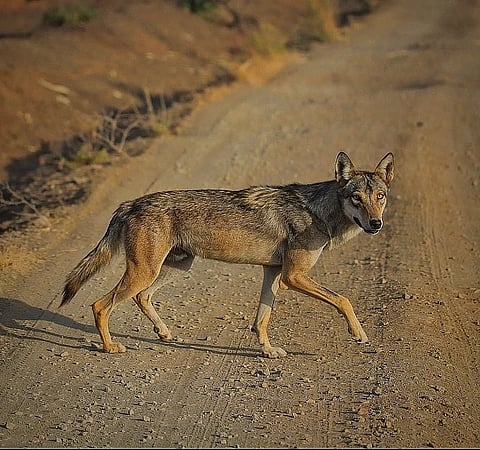Grey Wolf Spotted In Delhi After 80 Years
In an astonishing development for urban wildlife, a lone animal resembling the Indian grey wolf was recently sighted near the Yamuna floodplains in Palla, situated north of Delhi. The discovery marks what could be the first confirmed sighting of the species in the capital since the 1940s. The brief appearance of the elusive predator has sparked a significant interest in the circles of conservationists and wildlife enthusiasts, setting off various debates and discussions.
Grey Wolf Glimpse In Delhi
It was on a quiet morning that a local resident of Hemant Garg encountered an unexpected visitor during his walk along the Yamuna riverbank. He managed to procure photographs of the animal before it disappeared into the dense grasslands. Once verified, the sighting would be the first confirmed record of an Indian grey wolf in Delhi in over 80 years as the last documented presence dates as far back as the 1940s.
Such wildlife encounters are extremely uncommon in Delhi due to the city's growing urbanisation, which has resulted in severe habitat fragmentation. The discovery at Palla, where the Yamuna joins the city, emphasises how crucial it is to protect urban green zones like the Delhi Ridge and floodplains for ecological reasons. In the middle of the urban expansion, these places are essential wildlife refuges.
Understanding the Indian Grey Wolf
The elusive Indian grey wolf (Canis lupus pallipes) is a subspecies of the grey wolf that is better adapted to arid and semi-arid regions of the Indian subcontinent. Typically small and less vocal than their northern counterparts, these wolves are known for their elusive nature and adaptability to grassland habitats. Their populations have been dwindling due to habitat loss, human-wildlife conflict and hybridisation with domestic dogs.
The necessity of coordinated conservation efforts is underscored by the possible return of the Indian grey wolf to Delhi. The mobility and survival of such species can be facilitated by preserving and rehabilitating natural habitats in and around urban areas. Furthermore, reducing human-wildlife conflicts and guaranteeing the cohabitation of urban people with native species depend heavily on public knowledge and community involvement.
Next Steps
To verify the animal's identity, wildlife officials and specialists are now examining the photos and obtaining more proof. If confirmed, this sighting may lead to additional research on Indian grey wolf travel and the natural pathways that facilitate their spread. It also acts as a reminder of nature's tenacity and the surprises it can provide, even in the most unlikely locations.


